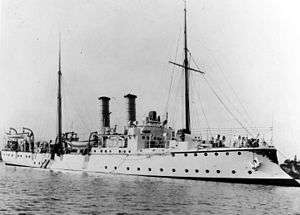SMS Eber
SMS Eber was the last of the six gunboats of the Iltis class of the German Imperial Navy prior to and during World War I. Other ships of the class are SMS Iltis, SMS Luchs, SMS Tiger, SMS Jaguar and SMS Panther. They were built between 1898 and 1903. All of them served primarily overseas, in the German colonies. Eber had a crew of 9 officers and 121 men.
 Eber's sistership Jaguar | |
| History | |
|---|---|
| Name: | Eber |
| Namesake: | SMS Eber |
| Builder: | AG Vulcan Stettin |
| Laid down: | 1902 |
| Launched: | 6 June 1903 |
| Completed: | 1903 |
| Fate: | Scuttled, 16 October 1917 |
| General characteristics | |
| Class and type: | Iltis-class gunboat |
| Displacement: | 1,193 metric tons (1,174 long tons) |
| Length: | 66.9 m (219.5 ft) |
| Beam: | 9.7 m (31.8 ft) |
| Draft: | 3.12 m (10.2 ft) |
| Installed power: | 1,300 ihp (970 kW) |
| Propulsion: |
|
| Speed: | 14 knots (26 km/h; 16 mph) |
| Complement: | 130 |
| Armament: | 2 × 1 - 10.5 cm (4.1 in) SK L/40 guns |
Design
Eber was 66.9 meters (219 ft) long overall and had a beam of 9.7 m (32 ft) and a draft of 3.54 m (11.6 ft) forward. She displaced 1,193 metric tons (1,174 long tons; 1,315 short tons) at full load. Her propulsion system consisted of a pair of vertical triple-expansion steam engines each driving a single screw propeller, with steam supplied by four coal-fired Thornycroft boilers. Eber could steam at a top speed of 14.3 knots (26.5 km/h; 16.5 mph) at 1,314 indicated horsepower (980 kW). The ship had a cruising radius of about 3,400 nautical miles (6,300 km; 3,900 mi) at a speed of 9 knots (17 km/h; 10 mph).[1] She had a crew of 9 officers and 121 enlisted men.[2] Eber was armed with a main battery of two 10.5 cm (4.1 in) SK L/40 guns, with 482 rounds of ammunition. She also carried six machine guns.[1][3]
Service history
The keel for Eber was laid down at the AG Vulcan in Stettin in 1902, much later than her five sister ships. She was launched on 6 June 1902 and commissioned into the German fleet on 15 September that year.[4]
Eber was posted in West African waters prior to World War I. During a port visit to Cape Town Eber received news of impending war with Great Britain, and immediately sailed to avoid capture. She arrived in German South-West Africa on August 1, 1914, three days prior to the formal declaration of war. After taking on coal at Lüderitz, the gunboat departed for South American waters, to assume wartime duties. She met up with the German passenger liner Cap Trafalgar off the Brazilian island of Trindade and transferred her guns, most of her ammunitions and some of her crew to the liner, which was then expected to operate as a commerce raider. Eber herself was interned in Brazil and scuttled by her crew on 16 October 1917 in Salvador, Bahia when Brazil joined the war against Germany.
Notes
- Gröner, p. 142
- Gröner, p. 143
- Gardiner, p. 260
- Gröner, pp. 142–153
References
- Gardiner, Robert, ed. (1979). Conway's All the World's Fighting Ships: 1860–1905. London: Conway Maritime Press. ISBN 0-85177-133-5.
- Gröner, Erich (1990). German Warships: 1815–1945. Vol. I: Major Surface Vessels. Annapolis: Naval Institute Press. ISBN 0-87021-790-9.